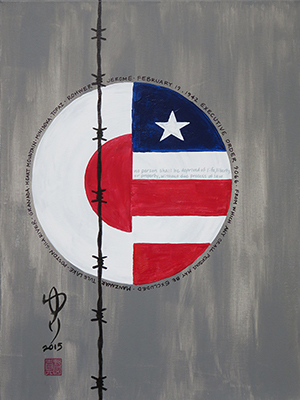And it seems to me important for a country, for a nation to certainly know about its glorious achievements but also to know where its ideals failed, in order to keep that from happening again. – George Takei
Most Americans have learned about the December 7, 1941 Japanese attack on Pearl Harbor. How many know about Executive Order 9066?
Following such discriminatory legislation as the Chinese Exclusion Act of 1882, the Alien Land Law of 1913, and the Japanese Exclusion Act of 1924, the hysteria about Asians in America, and in the Japanese in particular, had reached a fever pitch after Pearl Harbor. Racism and fear were again sanctioned by the U.S. government by then President Roosevelt when he signed and issued Executive Order 9066 on February 19, 1942. This authorized the Secretary of War and the Military Commanders to establish military zones and to use their discretion in determining the rights of those within those zones, regardless of the U.S. Constitution. This order was used as a justification in what is commonly known as the Japanese American Internment.
Using Census Bureau information, the government removed and imprisoned between 110,000 and 127,000 citizens and resident aliens of Japanese ancestry. Two-thirds of these individuals were native-born Americans. They were ultimately sent to ten so-called relocation centers, which were more accurately concentration camps. These people were oppressed simply because they looked like those who had attacked Pearl Harbor. As one can imagine, the conditions were terrible and tensions were high.
When some of the American internees tried to enlist in the military, they were categorized as enemy non-aliens and rejected, not even given their legal label of citizens. Then, as a result of a potentially confusing loyalty questionnaire, those who replied negatively to the last two questions regarding willingness to serve in the military and foreswearing allegiance to the emperor of Japan were known as “No Nos” and were sent to the Tule Lake camp, if they were not already incarcerated there.
After World War II ended, all the prisoners were released. In the book Impounded, Mine Okubo remembers feeling insulted when she was sent off from Topaz with a train ticket, $25, $3 per day for meals while traveling and When You Leave the Relocation Center, an instruction booklet by the War Relocation Authority on how to reintegrate into American society. On August 10, 1988 President Reagan signed the Civil Liberties Act of 1988, which offered a formal national apology and a $20,000 reparation payment to each surviving Japanese American who has been imprisoned in one of the concentration camps.
Two of the Japanese American children who were locked up in Tule Lake grew up to become much beloved actors – Pat Morita (Mr. Miyagi from the Karate Kid movies) and George Takei (Mr. Sulu of Star Trek fame). Pat Morita, who has sadly passed, has spoken about his first-hand experience. A powerful message is conveyed by George Takei in his June 2014 TedxKyoto presentation when recalling conversations with his father:
“…what I got from them [conversations] was my father’s wisdom. He was the one that suffered the most under those conditions of imprisonment, and yet he understood American democracy. He told me that our democracy is a people’s democracy, and it can be as great as the people can be, but it is also as fallible as people are. He told me that American democracy is vitally dependent on good people who cherish the ideals of our system and actively engage in the process of making our democracy work.”
This experience of Japanese internment is dear to my heart because had I lived in that time and area, I would have been incarcerated as a Nisei (second generation Japanese American). Though I thankfully did not have to endure that atrocity, I believe that we can learn from history and choose not to repeat such experiences. So what do we learn from all of this? Tom C. Clark, Retired Associate Justice of the U.S. Supreme Court, says it best in his quote from Executive Order 9066, The Internment of 110, 000 Japanese Americans:
“The truth is – as this deplorable experience proves – that constitutions and laws are not sufficient of themselves; they must be given life through implementation and strict enforcement. Despite the unequivocal language of the Constitution of the United States that the writ of habeas corpus shall not be suspended, and despite the Fifth Amendment’’ command that no person shall be deprived of life, liberty or property without due process of law, both of these constitutional safeguards were denied by military action under Executive Order 9066.”
“Let us determine to abide by the lessons the Executive Order 9066 teaches us – first, that the mere existence of a legal right is no more protection to individual liberty than the parchment upon which it is written, and second, that mutual love, respect, and understanding of one another are stronger bonds than constitutions.”
As a remembrance of the people affected by Executive Order 9066, I have created the painting shown above, so that I will be reminded to understand, educate, and actively take part in our democracy.
References
Chinese Exclusion Act. (2015, March 5). Retrieved April 18, 2015, from http://en.wikipedia.org/wiki/Chinese_Exclusion_Act
California Alien Land Law of 1913. (2014, November 14). Retrieved April 18, 2015, from http://en.wikipedia.org/wiki/California_Alien_Land_Law_of_1913
Immigration Act of 1924. (2015, April 9). Retrieved April 18, 2015, from http://en.wikipedia.org/wiki/Immigration_Act_of_1924
Executive Order 9066. (2015, March 25). Retrieved April 18, 2015, from http://en.wikipedia.org/wiki/Executive_Order_9066
Internment of Japanese Americans: Loyalty questions and segregation. (2015, April 17). Retrieved April 18, 2015, from http://en.wikipedia.org/wiki/Internment_of_Japanese_Americans#Loyalty_questions_and_segregation
Tule Lake Unit, World War II Valor in the Pacific National Monument. (2015, April 5). Retrieved April 18, 2015, from http://en.wikipedia.org/w/index.phptitle=Tule_Lake_Unit,_World_War_II_Valor_in_the_Pacific_National_Monument&redirect=no
Okihiro, G. Y. (2006). An American story. In L. Gordon & G. Y. Okihiro (Eds.), Impounded: Dorothea Lange and the censored images of Japanese American internment (pp. 47-84). New York, NY: W. W. Norton & Company.
TVLEGENDS. (2000, October 13). On having spinal tb as a kid and being escorted from the hospital to an internment camp in 1941 [Video file]. Retrieved from https://www.youtube.com/watch?v=2XpPbBoxBME
Why I love a country that once betrayed me [Video file]. (2014, June). Retrieved from http://www.ted.com/talks/george_takei_why_i_love_a_country_that_once_betrayed_me?language=en
Clark, T. C. (1992). Epilogue [Afterword]. In M. &. R. Conrat (Author), Executive Order 9066: The internment of 110,000 Japanese Americans (pp. 110-111). Los Angeles, CA: Asian American Studies Center.

